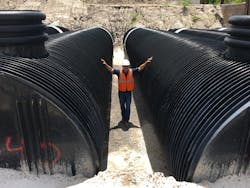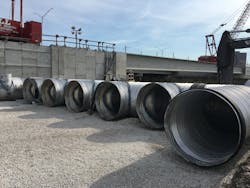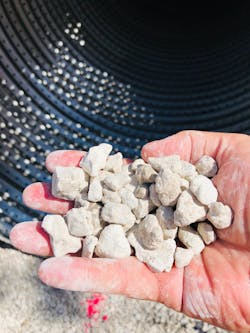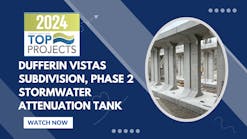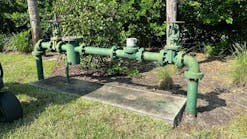The I-4 Ultimate reconstruction project through the heart of downtown Orlando has been one of the Country’s largest public infrastructure projects since notice to proceed was issued in October 2014. The $2.3-billion public-private partnership is the largest transportation project in Florida history. The project is currently estimated to be opened to the public in 2021.
In many ways, this project is emblematic of the challenges facing civil engineers today in many parts of the country. How do you balance the transportation and infrastructure needs of a large, fast-growing city while protecting the environment and maintaining recreational opportunities in an urban watershed? Through careful planning and consideration of site constraints, the I-4 Ultimate Reconstruction Project was able to do just that.
Paving the Way for the Future
The original I-4 roadway was built in the 1960s, long before Orlando became the tourist destination the city is today. The Orlando areas draw 60 million visitors a year, and I-4 sees more than 1.5 million daily trips. This has led Orlando to be one of the most congested cities, with 140,000 to 200,000 cars going through the I-4 Ultimate project limits daily.
The I-4 Ultimate project consists of the reconstruction of 21 miles of highway that runs through the heart of downtown Orlando. New Express Lanes with dynamic toll pricing and electronic toll collection will be added, and the general use lanes and auxiliary lanes will be rebuilt.
Seven underground stormwater storage systems were included in the project design to prevent flooding and control water quality. Underground storage was chosen because of a lack of land space and because the FDOT was working to build not only a functional Interstate but also an aesthetically pleasing corridor for Central Florida.
Protecting Water Quality in Lake Ivanhoe
Three of the underground stormwater detention systems are located in the area where I-4 crosses Lake Ivanhoe, a popular lake just north of downtown. Lake Ivanhoe totals 126 acres. The lake is in the heart of downtown, providing recreational activities such as wakeboarding and fishing and it is well-known to bird watchers.
Protecting water quality in this water body is a prime goal of the St. Johns River Water Management District (SJRWMD), one of five regional water management districts in Florida. In addition to providing the proper storage volume, the stormwater solution also needed to meet the permitting regulations with the SJRWMD that called for nutrient filtration removal rates of over 80% for phosphorous and over 50% for nitrogen of all runoff entering the lake. A typical Florida design for stormwater management, dry bottomed infiltration ponds are often considered to achieve these removal rates. However, high water tables in the planned pond areas precluded the required design storage volume and infiltration times from being met with traditional dry ponds. Detention with filtration of the drawdown discharge to meet pollutant removal goals for nutrients became the most viable option. The high groundwater elevations combined with limited available footprints, required that the detention system be designed to provide storage volume within the water table.
Contech Engineered Solutions consulted with I-4 Mobility Partners and presented a solution that met all of the design requirements for the project, which called for providing the proper storage requirements, addressing the high water table, fitting within the limited project easements, meeting the nutrient removal goals dictated by the SJRWMD, and providing an advantageous long term maintenance cycle/cost for the nutrient filtration and storage systems.
A third site was not built into the water table but was close enough to a high water table that dry ponds could still not be used. Site 3 used solid-wall CMP with gasketed joints.
The stored stormwater is treated before discharge into Lake Ivanhoe using the Stormwater Management StormFilter, an underground stormwater treatment device comprised of a concrete vault that houses rechargeable, media-filled cartridges that trap particulates and adsorb pollutants from stormwater runoff, including total suspended solids, hydrocarbons, nutrients, metals, and other common pollutants. StormFilter cartridges can be filled with media to target specific pollutants of concern. In this case, the cartridges were filled with PhosphoSorb, a lightweight media built from a Perlite base that removes total phosphorus (TP) by adsorbing dissolved-P and filtering particulate-P simultaneously. The use of PhosphoSorb enabled the engineers to meet the SJRWMD removal rates of over 80% for phosphorous and over 50% for nitrogen of all runoff entering the lake.
Planning for the Future
A unique contract requirement for this project mandates that I-4 Mobility Partners be responsible for the maintenance and repair of all systems installed for the project for the next 40-years. Of particular concern to the engineering team was the long-term maintenance costs of the StormFilter. Every manufactured filtration device will eventually need routine maintenance. The question was how often, how much it will cost, and what maintenance support will the manufacturer provide?
The StormFilter has been designed for predictable maintenance intervals ranging from 1 to 5 years, resulting in fewer maintenance events and reduced life cycle costs compared to other filtration devices. Contech has also created a Contech network of Certified Maintenance Providers to provide StormFilter maintenance at the lowest possible cost. In addition, Contech’s cartridge replacement program provides refurbished cartridges that are shipped to the site ready to install. Contech arranges for empty cartridges to be returned and recycled, reducing cartridge costs and environmental impact.
Contech presented the maintenance advantages of the StormFilter and history of its use on other FDOT projects to demonstrate how the solution would contribute to the I-4 Mobility Partners’ long term success on this project.
Additional Flood Control
In addition to the three sites near Ivanhoe Lake, six other detention systems were provided to prevent flooding along the reconstructed roadway. The six systems used a combined 6,411 linear feet of 48-inch, 60-inch, and 72-inch perforated, ALT2 corrugated metal pipe, providing 1,077,636 gallons of storage in the pipe. Additional storage was achieved by using perforated CMP and limestone backfill. With the proximity to I-4, accessibility and speed of construction were very important for the contractor. The inherent nature of CMP’s longer lengths (24-foot joints) and lighter Aluminized Steel pieces allowed for fewer delivery trucks, smaller pieces of installation equipment on site, and quick installation.
A well-graded granular limestone was used for the backfill of the system. The limestone allowed for easy compaction, as well as good drainage throughout the entire system.
Work on the I-4 Ultimate Project is ongoing. Once the roadway is complete, the drainage systems will be connected and bring these systems into use.
Building Sustainable Infrastructure
The I-4 Ultimate Improvement Project earned the prestigious Envision Platinum recognition from the Institute for Sustainable Infrastructure (ISI) for its ongoing programs to minimize environmental impacts, including relocating protected wildlife, using efficient machinery, controlling stormwater runoff, planting non-invasive vegetation, and recycling 99% of the concrete and steel removed from roads and bridges. This is the first project in Florida to receive recognition from ISI’s Envision sustainable infrastructure rating system.
Chris Landt
Chris Landt is Contech’s stormwater consultant for the Southeast region. Landt has 23 years of experience in the field of stormwater treatment and management. He helped found CDS Technologies Inc., which became a part of Contech in late 2006.
Robert Morris
Robert Morris is a regional engineer for Contech Engineered Solutions. Morris has worked with Contech for over 20 years since. Robert is a past recipient of ASCE’s Younger Civil Engineer of the Year Award for the GA Section and is also a past recipient of the President’s Award for outstanding service to the section.
